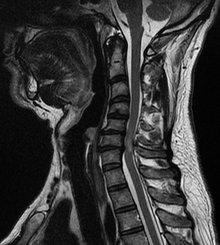Cervical myelopathy
A cervical myelopathy is damage to the spinal cord of the cervical spine , the Cervikalmarks .
Clinical picture
Herniated discs or other processes that take up space in the lumbar spine only rarely result in damage to the spinal cord, which could then lead to corresponding symptoms. Most herniated discs occur in segments L4 / L5 and L5 / S1, a few still occur in L3 / L4, and disc damage in other segments is an extremely rare occurrence. The spinal cord ends at the level of segment L1 / L2, below this point only nerve roots run in the spinal canal.
The situation is different in the cervical spine: Damage to the intervertebral disc or other processes that occupy space can, if they occur in an unfavorable place, lead to damage to the spinal cord. If the herniated disc does not press exactly in the middle on the spinal cord, " half-sided symptoms " usually occur . Parasitic sensations in one half of the body, differences in reflexes, and disorders of movement coordination can result. A “feeling of current” is often indicated, which in some positions of the cervical spine twitches through one half of the body like lightning. Depending on how big the incident is, it can also lead to more or less complete "high paraplegic symptoms ". In addition to the function of the arms and legs, the respiratory muscles or the control of the bladder and rectum are also affected.
therapy
Such neurological symptoms require immediate intervention. The spinal cord must be surgically relieved as soon as possible. Because of the local conditions, which differ considerably from those in the lumbar spine, the intervertebral disc space on the cervical spine is mostly approached from the front / side. The operation-related instability is prevented by blocking the affected segment afterwards. The body's own bone, a plastic block and / or osteosynthesis material can be used for this. As with all surgical interventions that improve the stability of a spinal column segment, sooner or later, instability can develop in an adjacent floor. With the gold standard technique of ACDF (Anterior cervical discectomy and fusion), the risk of developing subsequent degeneration is around 3% after each postoperative year. Stabilizing gymnastics, careful exercise and possibly vocational rehabilitation are important for prevention.
Web links
- Myelopathy - Information, Diagnoses & Therapies
Individual evidence
- ↑ Anterior Cervical Discectomy and Fusion (ACDF). Retrieved June 6, 2020 .
- ↑ Alan S. Hilibrand, Gregory D. Carlson, Mark A. Palumbo, Paul K. Jones, Henry H. Bohlman: radiculopathy and Myelopathy at segment Adjacent to the site of a Previous Anterior Cervical Arthrodesis *: . In: The Journal of Bone & Joint Surgery . tape 81 , no. 4 , April 1999, ISSN 0021-9355 , p. 519–28 , doi : 10.2106 / 00004623-199904000-00009 ( lww.com [accessed June 6, 2020]).
